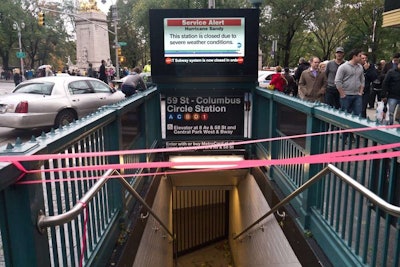 Subway station closed down one day after Hurricane Sandy October 30, 2012 in New York City. Credit: Donald Bowers Photography / Shutterstock.com
Subway station closed down one day after Hurricane Sandy October 30, 2012 in New York City. Credit: Donald Bowers Photography / Shutterstock.comMayor Bloomberg announced on February 6 plans to use some of New York City’s federal Superstorm Sandy aid money to repair homes, install generators at public housing complexes and create new storm-resistant technology, the Associated Press reported.
Among other plans for the city’s aid money are nearly $200 million in grants and loans for businesses Sandy hit and a $40 million contest for utilities to make power, fuel and phone networks more storm-resistant.
The plans Bloomberg revealed on Wednesday concern just a first portion of the funds: nearly $1.8 billion for the city in what are known as community development block grants, which generally have to be used for affordable housing, job-creation and social services.
City officials expect to get more money, though they’re not yet sure exactly how much, for purposes such as rebuilding roads and reimbursing city workers’ overtime.
However, the plans still need approval from the federal Housing and Urban Development Department. City officials are optimistic about receiving approval and hope to have the programs started by late April or early May.
The plans include: $350 million for up to 9,300 low-to-middle-income homeowners to fix damage beyond what can be addressed by the city’s Rapid Repairs program; $250 million for apartment buildings that are habitable but still need significant repairs, including nearly 13,000 low-to-middle-income apartments; $120 million for measures, such as generators, to make public housing more resistant to future storms; Loans of up to $150,000 and grants of up to $60,000, amounting to $80 million total, to help businesses recover from Sandy’s effects such as flooding and power outages; and $100 million to divide into grants of $100,00 for small businesses and $1 million for large businesses to make them more storm-resistant.
Additionally, Bloomberg’s administration has launched several competitions, such as designing micro-apartments and choosing an institution to create a technology-focused graduate school, to bring about new ideas.
Some of the plans for competitions include $5 million competition for flood-proofing and other storm-resiliency technology, the $40 million contest for utilities and a $100 million competition aimed at attracting companies or otherwise spurring economic development in storm-struck sections of lower Manhattan and coastal Brooklyn, Queens and Staten Island.
Bloomberg said the city’s focus is on trying to return people to their homes.










